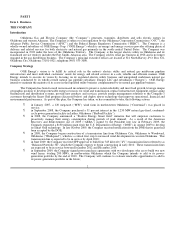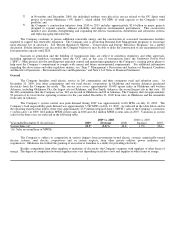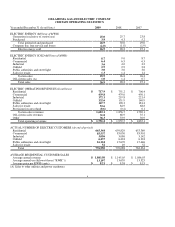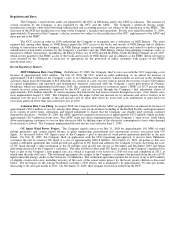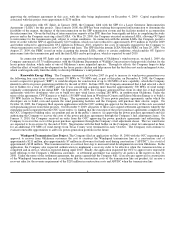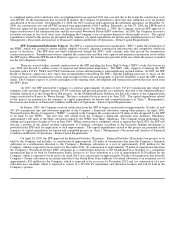OG&E 2009 Annual Report Download - page 15
Download and view the complete annual report
Please find page 15 of the 2009 OG&E annual report below. You can navigate through the pages in the report by either clicking on the pages listed below, or by using the keyword search tool below to find specific information within the annual report.
Wind
The Company’s current wind power portfolio includes: (i) the 120 MW Centennial wind farm, (ii) the 101 MW OU Spirit
wind farm placed in service in November and December 2009 and (iii) access to up to 50 MWs of electricity generated at a wind farm
near Woodward, Oklahoma from a 15-year contract the Company entered into with FPL Energy that expires in 2018.
The Company announced in October 2007 its goal to increase its wind power generation over the following four years from
its then current 170 MWs to 770 MWs and, as part of this plan, on December 8, 2008, the Company issued an RFP to wind developers
for construction of up to 300 MWs of new capability which the Company intends to add to its power-generation portfolio by the end
of 2010. As part of this RFP process, on September 29, 2009, the Company announced that it had reached agreements with two
developers who are to build two new wind farms, totaling 280 MWs, in northwestern Oklahoma. Under the terms of the agreements,
CPV Keenan is to build a 150 MW wind farm in Woodward County and Edison Mission Energy is to build a 130 MW facility in
Dewey County near Taloga. The agreements are both 20-year power purchase agreements, under which the developers are to build,
own and operate the wind generating facilities and the Company will purchase their electric output. On January 5, 2010, the Company
received an order from the OCC approving the power purchase agreements and authorizing the Company to recover the costs of the
power purchase agreements through the Company’s fuel adjustment clause.
Safety and Health Regulation
The Company is subject to a number of Federal and state laws and regulations, including the Federal Occupational Safety and
Health Act of 1970 (“OSHA”) and comparable state statutes, whose purpose is to protect the safety and health of workers. In addition,
the OSHA hazard communication standard, the U.S. Environmental Protection Agency (“EPA”) community right-to-know regulations
under Title III of the Federal Superfund Amendment and Reauthorization Act and comparable state statutes require that information
be maintained concerning hazardous materials used or produced in the Company’s operations and that this information be provided to
employees, state and local government authorities and citizens. The Company believes that it is in material compliance with all
applicable laws and regulations relating to worker safety and health.
ENVIRONMENTAL MATTERS
General
The activities of the Company are subject to stringent and complex Federal, state and local laws and regulations governing
environmental protection including the discharge of materials into the environment. These laws and regulations can restrict or impact
the Company’s business activities in many ways, such as restricting the way it can handle or dispose of its wastes, requiring remedial
action to mitigate pollution conditions that may be caused by its operations or that are attributable to former operators, regulating
future construction activities to avoid endangered species or enjoining some or all of the operations of facilities deemed in
noncompliance with permits issued pursuant to such environmental laws and regulations. In most instances, the applicable regulatory
requirements relate to water and air pollution control or solid waste management measures. Failure to comply with these laws and
regulations may result in the assessment of administrative, civil and criminal penalties, the imposition of remedial requirements, and
the issuance of orders enjoining future operations. Certain environmental statutes can impose burdensome liability for costs required
to clean up and restore sites where substances or wastes have been disposed or otherwise released into the environment. Moreover, it
is not uncommon for neighboring landowners and other third parties to file claims for personal injury and property damage allegedly
caused by the release of substances or wastes into the environment. the Company handles some materials subject to the requirements
of the Federal Resource Conservation and Recovery Act and the Federal Water Pollution Control Act of 1972, as amended (“Federal
Clean Water Act”) and comparable state statutes, prepare and file reports and documents pursuant to the Toxic Substance Control Act
and the Emergency Planning and Community Right to Know Act and obtain permits pursuant to the Federal Clean Air Act and
comparable state air statutes.
The Company believes that its operations are in substantial compliance with applicable environmental laws and
regulations. The trend in environmental regulation, however, is to place more restrictions and limitations on activities that may affect
the environment. For example, as discussed below, in 2009, the EPA adopted a finding that greenhouse gases contribute to pollution
and the EPA proposed rules related to the control of greenhouse gas emissions. The Company cannot assure that future events, such
as changes in existing laws, the promulgation of new laws, or the development or
11



